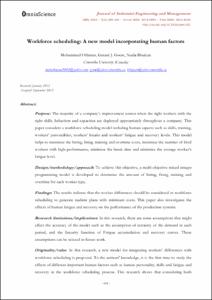Mostra el registre d'ítem simple
Workforce scheduling: a new model incorporating human factors
| dc.contributor.author | Othman, Mohammed |
| dc.contributor.author | Gouw, Gerard J. |
| dc.contributor.author | Bhuiyan, Nadia |
| dc.date.accessioned | 2013-01-21T09:21:17Z |
| dc.date.available | 2013-01-21T09:21:17Z |
| dc.date.issued | 2012-12 |
| dc.identifier.citation | Othman, Mohammed; Gouw, Gerard J.; Bhuiyan, Nadia. Workforce scheduling: a new model incorporating human factors. "Journal of Industrial Engineering and Management", Desembre 2012, vol. 5, núm. 2, p. 259-284. |
| dc.identifier.issn | 2013-0953 |
| dc.identifier.uri | http://hdl.handle.net/2099/12953 |
| dc.description.abstract | Purpose: The majority of a company’s improvement comes when the right workers with the right skills, behaviors and capacities are deployed appropriately throughout a company. This paper considers a workforce scheduling model including human aspects such as skills, training, workers’ personalities, workers’ breaks and workers’ fatigue and recovery levels. This model helps to minimize the hiring, firing, training and overtime costs, minimize the number of fired workers with high performance, minimize the break time and minimize the average worker’s fatigue level. Design/methodology/approach: To achieve this objective, a multi objective mixed integer programming model is developed to determine the amount of hiring, firing, training and overtime for each worker type. Findings: The results indicate that the worker differences should be considered in workforce scheduling to generate realistic plans with minimum costs. This paper also investigates the effects of human fatigue and recovery on the performance of the production systems. Research limitations/implications: In this research, there are some assumptions that might affect the accuracy of the model such as the assumption of certainty of the demand in each period, and the linearity function of Fatigue accumulation and recovery curves. These assumptions can be relaxed in future work. Originality/value: In this research, a new model for integrating workers’ differences with workforce scheduling is proposed. To the authors' knowledge, it is the first time to study the effects of different important human factors such as human personality, skills and fatigue and recovery in the workforce scheduling process. This research shows that considering both technical and human factors together can reduce the costs in manufacturing systems and ensure the safety of the workers. |
| dc.format.extent | 26 p. |
| dc.language.iso | eng |
| dc.publisher | School of Industrial and Aeronautic Engineering of Terrassa (ETSEIAT). Universitat Politècnica de Catalunya (UPC) |
| dc.rights | Attribution-NonCommercial 3.0 Spain |
| dc.rights.uri | http://creativecommons.org/licenses/by-nc/3.0/es/ |
| dc.subject | Àrees temàtiques de la UPC::Economia i organització d'empreses::Gestió i direcció::Recursos humans |
| dc.subject | Àrees temàtiques de la UPC::Matemàtiques i estadística::Investigació operativa |
| dc.subject.lcsh | Manpower planning |
| dc.subject.lcsh | Computer scheduling |
| dc.subject.other | Fatigue |
| dc.subject.other | Human factors |
| dc.subject.other | Personality |
| dc.subject.other | Workforce scheduling |
| dc.title | Workforce scheduling: a new model incorporating human factors |
| dc.type | Article |
| dc.subject.lemac | Recursos humans -- Planificació |
| dc.subject.lemac | Planificació de tasques (Informàtica) |
| dc.identifier.dl | B-28744-2008 |
| dc.description.peerreviewed | Peer Reviewed |
| dc.rights.access | Open Access |
| local.citation.author | Othman, Mohammed; Gouw, Gerard J.; Bhuiyan, Nadia |
| local.citation.publicationName | Journal of Industrial Engineering and Management |
| local.citation.volume | 5 |
| local.citation.number | 2 |
| local.citation.startingPage | 259 |
| local.citation.endingPage | 284 |
Fitxers d'aquest items
Aquest ítem apareix a les col·leccions següents
-
2012, vol. 5, núm. 2 [16]


